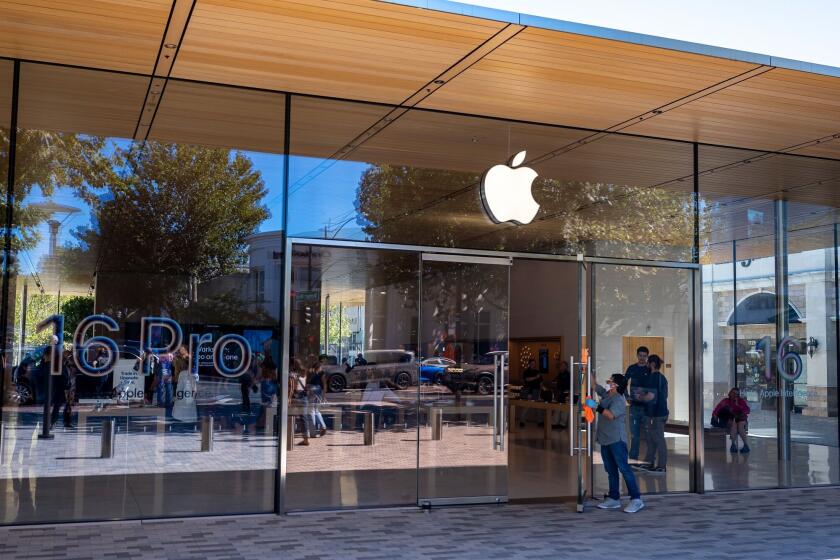Anatomy of a City Without Angels
- Share via
In Los Angeles’ libraries and theaters, hospitals and museums, shelters and clinics, the inevitable donor walls differ in size and style and content, but most of them have at least two things in common--the names Arco and Times Mirror. For decades, these two corporate foundations stood as symbols of the business sector’s commitment to creating a world-class city, a vital downtown.
This year, as Arco and Times Mirror are expected to be swallowed by BP Amoco and Tribune Co., respectively, downtown Los Angeles will lose not only its two remaining Fortune 500 companies, but also its two most visible corporate philanthropists. Private foundations, which are booming in California, have the resources to replace any lost dollars, but many in the philanthropic community still consider the changes a devastating loss for the charitable landscape.
The Times’ philanthropic participation predates the 1962 creation of its foundation--the account of how Dorothy Chandler almost single-handedly saved the Hollywood Bowl and bridged the infamous downtown-Westside culture gap to build the Music Center has become local legend. In 1984, Times Mirror helped bankroll the wildly successful Olympics and, more recently, came to the aid of the stalled Disney Concert Hall.
Arco’s former President Lodwrick Cook enjoys a similar reputation. In 1986, he and then-president Robert Anderson rescued the burned-out Central Library with the Save the Books program. Six years later, after the 1992 riots, Cook became chairman of Rebuild L.A. and helped resurrect many small businesses.
In between such Herculean tasks, the two foundations annually doled out millions to local programs and organizations too numerous and disparate to name or categorize. Last year alone the two gave out a combined total of about $18 million.
The assurances from both prospective new owners have been vehement and oft-repeated--as early as November of last year, BP Amoco pledged to make $100 million in charitable contributions over 10 years in California, and Tribune officials have pledged to honor The Times’ heritage of generosity, pointing out that their own foundations gave $5 million to groups in the Los Angeles area last year.
At the Times Mirror Foundation, staff members are in the midst of compiling an analysis of the foundation’s giving profile in the hopes of ensuring that the programs now funded are fairly represented when the Tribune takes over.
“There will definitely be something, some sort of foundation associated with The Times,” says Michelle Williams, executive director of the foundation. “It probably won’t be named Times Mirror Foundation, and a lot more needs to be worked out, but bottom line, Los Angeles will continue to get money.”
Many within the giving community, however, remain unconvinced. Unconvinced, and a bit shellshocked. Three days after the Times Mirror sale was announced, Jack Shakely, president of the California Community Foundation, blistered the pages of this newspaper’s Opinion section, claiming that Los Angeles is in the throes of “philanthropic-death-by-merger.” Citing the loss of various giants, including Getty Oil, Security Pacific National Bank and Bullock’s, Shakely wrote that no matter what the intentions of a new long-distance owner, “geography is our enemy.”
His feelings are shared by many.
The loss of Arco and Times Mirror “affects the landscape very dramatically,” says Barry Munitz, president of the J. Paul Getty Trust. “Both have been very key players. Yes, things have been changing--management is much more transient, you don’t have the entrepreneurial owners that you did 10 years ago, but still the loss makes a huge difference.”
“The bottom line is that corporations give most where they are located,” says Lon Burns, a consultant for nonprofits and the former president of the Southern California Assn. of Philanthropy. “You have to assume that when a funder that size leaves, some programs will die.”
*
Overall, the loss may be as much symbolic as financial. Corporate giving makes up a very small percentage of nonprofit funding and has, despite the last few years of merger mania, increased during the last decade. In California, the recent explosion of wealthy private foundations has sent the philanthropic payout soaring to more than $2 billion annually. Locally, the relatively recent high-volume participation by the California Wellness Foundation, the California Endowment and the thriving California Community Foundation would more than compensate, in sheer dollars anyway, for the $12 million given out by Arco and the $6 million by Times Mirror in 1999.
“Obviously mergers and acquisitions are affecting many cities,” says Stacy Palmer, editor of the Chronicle of Philanthropy. “And certain groups that have become dependent will have to acquire the skills to seek funding elsewhere. But given the economy and the emergence of so many new sources, there probably won’t be a net-loss problem.”
But, many argue, the amount Arco and Times Mirror spent was not as important as the way in which they spent it. The two foundations were models of broad-based civic funding, which seems to be on the wane even as the lists of local grant totals soar.
“There is little question that there is more philanthropic money in the state than ever before,” says Gary Yates, president and CEO of the Wellness Foundation. “But corporate foundations tend to focus on the area of the headquarters, they tend to know a lot more about local needs. Especially an organization like Times Mirror. We give away $45 million a year,” he adds, “which sounds like a lot of money, and it is, but we are a statewide organization, and that gets diluted pretty quickly.”
Yates also points out that his foundation, as well as the California Endowment, are the products of health-care conversions and so are limited in the types of grants they can make--both focus on health-care issues. The trend among many new private foundations, and even among some long-standing institutions like the United Way, is to increase impact by narrowing giving to specific target groups--the working poor, as in the case of the United Way, or K-12 education.
“The new venture philanthropists speak a completely different language,” Munitz says. “Yes, there’s a lot of money and good motives, but many of these people don’t know how to support a city. The real conversation is how do you re-create an inner fabric on behalf of the city? [Former Times Mirror Chief Executive] Bob Erburu is on my board, he’s also on the Huntington board. He knows this city. Where are these people going to come from now?”
While Erburu himself is adopting a wait-and-see attitude toward the effect of the changes, he believes that even more important than the money is a company’s willingness to allow its top executives to commit time to local nonprofits.
“The demands on a CEO are so great,” he says, “and working in the community takes time away from the workday. But when the staff [of a nonprofit] sees such a volunteer working right with them, that has an impact more valuable than dollars.”
*
The new philanthropists are often less concerned than the old guard with promoting the health of a particular city. Which is why, as charitable contributions across the country have soared, the arts and humanities have found themselves struggling just to maintain funding, much less increase it.
“The new money cares about the arts,” Munitz says, “but not as profoundly as, say, education and health issues. Because they are very bottom line. And while you can make the argument that if we don’t fix [the Los Angeles Unified School District], we are all at risk, you can’t, with a straight face, say the same about building Disney Hall.”
But, he adds, historically, the well-being of the arts is a very good indication of where a city falls in the international hierarchy. For reasons that may have had to do more with real estate value than saintliness, previous generations of the Otis and Chandler families were very interested in raising Los Angeles to the pantheon of first-class international cities.
Likewise, Cook and other headquartered chief executives had a similar investment--a top-notch city draws top-notch people. To reach corporate leaders not headquartered in their own city, nonprofits have to figure out how to make the case that they matter, specifically, to the company in question. Relying on the goodness of someone’s heart doesn’t cut it in today’s competitive nonprofit market.
“The really critical thing in cases like this is that the charitable community must mobilize and put pressure on the incoming corporations to honor their commitments,” Palmer says.
*
Mary McNamara can be reached at mary.mcnamara@latimes.com.
More to Read
Inside the business of entertainment
The Wide Shot brings you news, analysis and insights on everything from streaming wars to production — and what it all means for the future.
You may occasionally receive promotional content from the Los Angeles Times.










